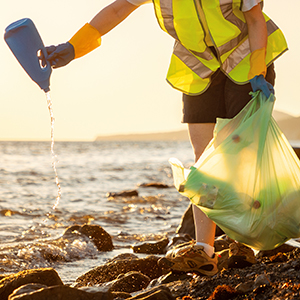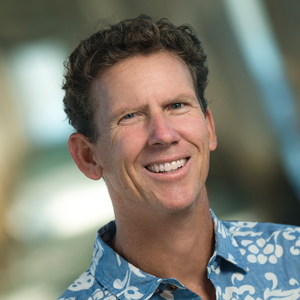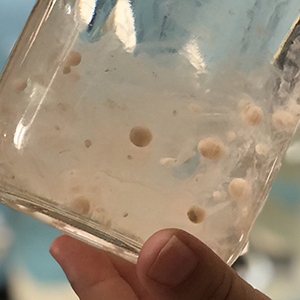Climate change and warming waters are activating two massive seedbeds of a harmful algal bloom (HAB) species called Alexandrium catenella in the Alaskan Arctic, according to NIEHS-funded researcher Donald Anderson, Ph.D. He is a senior scientist with the Woods Hole Oceanographic Institution (WHOI), where he directs the U.S. National Office for Harmful Algal Blooms. Such blooms include overgrowths of toxic algae that can negatively affect human health, disrupt ecosystems, and threaten food security.
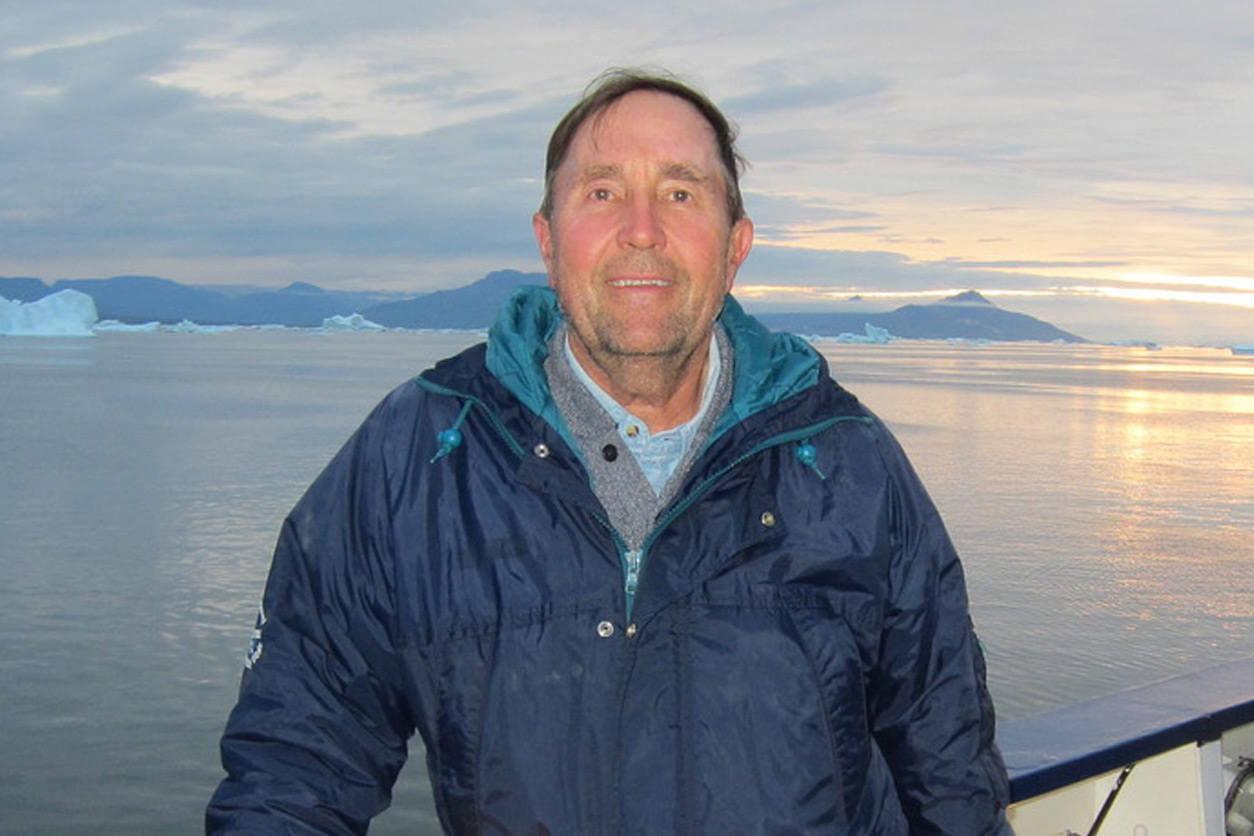 Anderson posed for a photo while conducting harmful algal bloom research off the northwest coast of Greenland in August 2012. (Photo courtesy of Mindy Richlen / Woods Hole Oceanographic Institution)
Anderson posed for a photo while conducting harmful algal bloom research off the northwest coast of Greenland in August 2012. (Photo courtesy of Mindy Richlen / Woods Hole Oceanographic Institution)Environmental Factor recently spoke with Anderson to learn more about his latest research — published Oct. 12 in the Proceedings of the National Academy of Sciences — and what he and other scientists are doing to address HABs and their potential human health effects.
Paralytic shellfish poisoning, other concerns
Environmental Factor: Can you discuss your research regarding HABs in the Alaskan Arctic?
Donald Anderson: We are trying to understand how toxic microscopic algae function in the rapidly changing waters of the Alaskan Arctic. Our goal is to understand effects both in the ocean and on Indigenous communities. This paper documents two huge accumulation zones for dormant cysts of one toxic species, the dinoflagellate Alexandrium catenella. These massive cyst beds dwarf anything we have seen anywhere in the world.
The blooms in surface waters originate in part from the germination of these cysts, and they also are very large and dense with cells — certainly dense enough to have dangerous levels of toxins for humans and for animals that rely on that regional food web for sustenance.
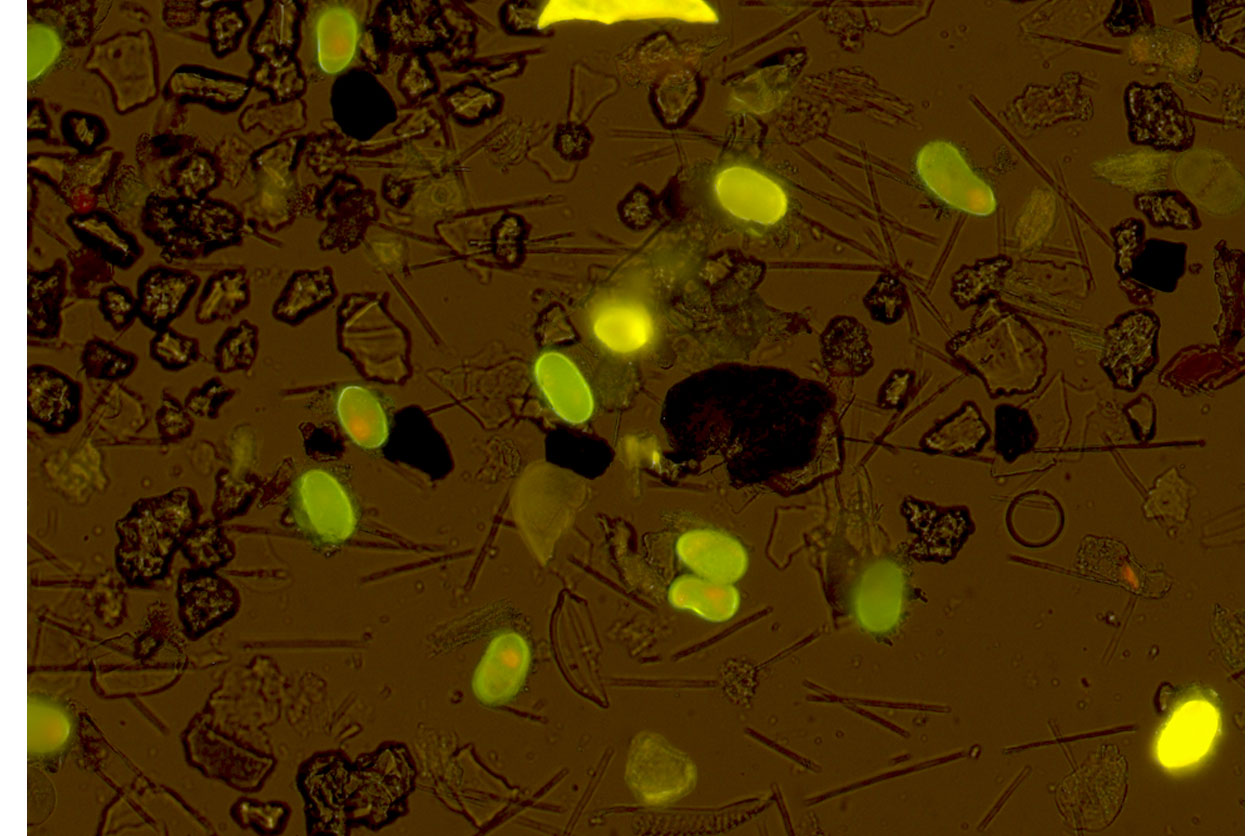 Alexandrium catenella cysts (yellow-green capsules) in a sediment sample. The cysts were stained with a chemical that makes them easy to see using epifluorescence microscopy. (Image courtesy of Evangeline Fachon)
Alexandrium catenella cysts (yellow-green capsules) in a sediment sample. The cysts were stained with a chemical that makes them easy to see using epifluorescence microscopy. (Image courtesy of Evangeline Fachon)As part of this HAB research, we are investigating a suite of toxins produced by Alexandrium catenella called saxitoxins, which cause the potentially fatal human syndrome known as paralytic shellfish poisoning. Such poisoning is common in the northeast United States and along much of the West Coast, including in southeast Alaska. Further north, in the Alaskan Arctic, outbreaks of Alexandrium catenella have historically been rare, but now we believe they will be much more frequent and even annually recurrent due to warming trends.
In that region, everything is different from our studies elsewhere in terms of potential human health effects. Indigenous communities do not eat many shellfish. They instead consume seabirds, seals, walruses, whales, and other marine animals, many of which are potential vectors for the toxins. These are new pathways to us, and thus human exposure is not yet well understood.
Adding stress to already stressed ecosystem
EF: What are major takeaways from your research in terms of effects on ecosystems and human health?
DA: We note several major implications. The first is there is now a new mechanism that can lead to toxic blooms of Alexandrium catenella in the Chukchi and Beaufort Sea regions. Previously, we knew that on occasion, established blooms could be carried from the northern Bering Sea into the cold Arctic waters via the Bering Strait. However, we believed that bottom waters were too cold for that organism to complete its life cycle, meaning that cysts formed by those blooms and deposited in Arctic sediments could not germinate to initiate blooms in that region in subsequent years.
 For reference, the Chukchi and Beaufort Seas are highlighted in red. Note the Bering Strait passage between Alaska and Russia. (Photo courtesy of Peter Hermes Furian / Shutterstock.com)
For reference, the Chukchi and Beaufort Seas are highlighted in red. Note the Bering Strait passage between Alaska and Russia. (Photo courtesy of Peter Hermes Furian / Shutterstock.com)In our paper, we termed the massive, dense Alexandrium catenella cyst beds a “sleeping giant,” waiting for waters to warm. Based on our research in the WHOI Center for Oceans and Human Health, which is funded by NIEHS and the National Science Foundation, we now believe that waters have warmed sufficiently for Alexandrium catenella to complete its entire life cycle in the Chukchi Sea. During the past two decades, bottom waters have warmed sufficiently for the number of germinated cysts to increase more than twofold while also advancing the timing for bloom initiation by nearly three weeks.
The second takeaway is that HABs are an added stressor on an already stressed ecosystem due to climate change. There is already abundant evidence for warming-driven range shifts and population changes of algae, zooplankton, crabs, fish, and other food resources, and each affects higher levels of the food web. For example, king crab stocks have dramatically decreased, probably because the environment is too warm. People now fish for pollack in the Arctic and take ships all the way across the Northwest Passage because there is no more ice to stop them.
To have potent toxins more prevalent in that food web is yet another stressor that can further damage fragile and struggling ecosystems and indirectly affect human food security. There are a lot of unexplained mortalities of sea birds, walruses, and even whales that might reflect the added stress from HAB toxins. And, of course, consumption of contaminated marine food and harvest species directly affects human health.
There is no question that there is a threat to human and ecosystem health, and yet it is currently difficult to quantify that risk because of our lack of knowledge about some of the complex interactions and pathways for toxin transfer. Unlike shellfish, which can continue filtering the water even when they contain dangerous levels of toxins, it may be that many animals will die before toxins in the tissues that are commonly consumed by people reach levels that are of concern. Therefore, the direct human health impacts may not be as serious as the indirect ones, which are related to ecosystem disruption by the toxins.
I need to emphasize that we also don’t yet know the lethal doses for these animals, so it is hard to attribute toxins as the cause of recent mortalities. Nevertheless, there is a clear food security risk to humans from HABs that may be equal to or greater than risk from consumption of contaminated products. Fortunately, we now have funding through NOAA [National Oceanic and Atmospheric Administration] to carefully examine food web transfer of HAB toxins.
Community monitoring, HAB biosensors
EF: What can be done to minimize those direct and indirect effects on human health?
DA: The nature of the Alaskan coastline, population distribution, and weather all greatly complicate efforts to monitor and manage HABs in the Arctic. The state currently tests only a small fraction of the massive coastline for marine toxins, so some tribes and communities are collecting their own samples and sending them to a testing lab set up by the Sitka Tribe in southeast Alaska. A similar program could be established for northern communities.
Community monitoring of food resources and the water can provide a level of early warning, while clear and accurate communication can inform people of the times when certain resources might be dangerous. Another promising approach is the installation of instruments that autonomously detect and measure HAB cells and toxins along key current pathways, providing valuable early-warning information 24/7. Several types of HAB-specific biosensors are now commercially available. None are yet deployed in the Arctic, but we hope that this will change as part of a growing national HAB observing network being funded at a pilot scale by Congress.
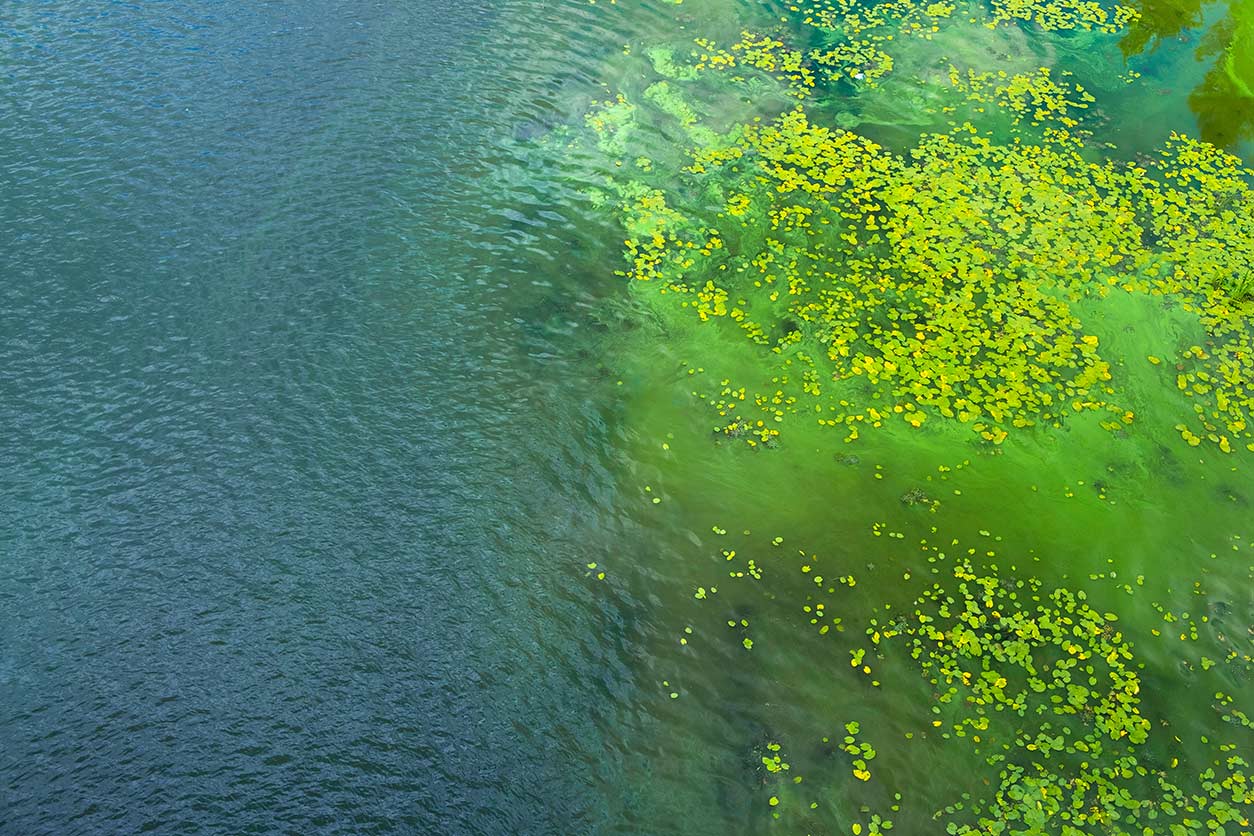 The NIEHS health topic page on harmful algal blooms offers a rundown of their potential health effects and information about institute grantees’ related research. (Photo courtesy of shablovskyistock / Shutterstock.com)
The NIEHS health topic page on harmful algal blooms offers a rundown of their potential health effects and information about institute grantees’ related research. (Photo courtesy of shablovskyistock / Shutterstock.com)Controlling outbreaks, protecting health
EF: Is it possible to directly control or suppress blooms, the way we control pests or diseases in agriculture?
DA: HAB control is a very active area of research at the present, but unfortunately, most of the approaches that are relatively well advanced are unlikely to be of use against Alexandrium catenella in the Arctic.
In Florida, where there are strong incentives to control nearly annual outbreaks of HABs, some blooms are dense enough to make the water appear red, and the cells aggregate at the surface. That makes them a good target for a method used in Asia to protect fish farms and other resources. The approach involves spraying a modified clay onto the water surface.
The clay particles aggregate with each other and with other particles in the water, including HAB cells, and that process makes particles and cells heavy and carries them to the sea floor. The method has been applied over 50- to 100-square-mile areas in Asia on many occasions, but in U.S. coastal waters, the most we can presently do at one time — because of unresolved environmental concerns — is about a half an acre.
In Alaska, although the cell concentrations are high enough to be dangerous, they are not sufficiently high for this bloom control method to work. For now, we need to manage the problem though surveillance and communication.
Citation: Anderson DM, Fachon E, Pickart RS, Lin P, Fischer AD, Richlen ML, Uva V, Brosnahan ML, McRaven L, Bahr F, Lefebvre K, Grebmeier JM, Danielson SL, Lyu Y, Fukai Y. 2021. Evidence for massive and recurrent toxic blooms of Alexandrium catenella in the Alaskan Arctic. Proc Natl Acad Sci U S A 118(41):e2107387118.
(Jennifer Harker, Ph.D., is a technical writer-editor in the NIEHS Office of Communications and Public Liaison.)





